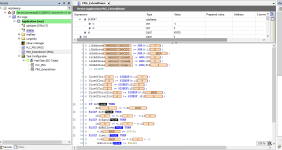I declare a structure:
I declare a UNION:
I declare a variable:
Now I can access variable fields:
But I want do it without "n":
How I can declarate UNION for it? I thought:
But it is wrong.
Code:
TYPE sdoName:
STRUCT
i1: INT;
i2: INT;
END_STRUCT
END_TYPE
Code:
TYPE uName:
UNION
di : DINT;
n : sdoName;
END_UNION
END_TYPE
Code:
VAR
v: uName;
END VAR
Code:
diX := v.di;
iX1 := v.n.i1;
iX2 := v.n.i2;
Code:
diX := v.di;
iX1 := v.i1;
iX2 := v.i2;
Code:
TYPE uName:
UNION
di : DINT;
STRUCT
i1: INT;
i2: INT;
END_STRUCT
END_UNION
END_TYPE








